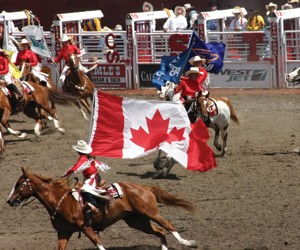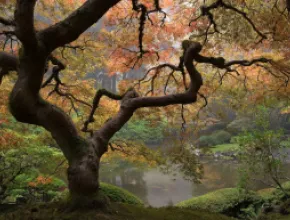In 1670, Charles II of England granted most of North America, much of present day Western Canada included, to the Hudson’s Bay Company. Two centuries later, in 1870, the newly formed Dominion of Canada bought back the territory, named “Rupert’s Land” after the king’s cousin.
Originally explored by fur traders, the prairie provinces of Manitoba (“Great Spirit”), Saskatchewan (“Land of Living Skies”) and Alberta (named for one of Queen Victoria’s daughters) were thrown open to settlers by the new government’s offer of free land. Its coastline first explored by James Cook in 1778, British Columbia’s mountains long barred the overland route to the Pacific—until 1885, when the last spike of the transcontinental railroad was driven home in the former colony’s interior.
“Bringing the goods to a young, growing land,” famed Canadian musician Gordon Lightfoot sang in his Canadian Railroad Trilogy, commissioned by the Canadian Broadcasting Corporation in 1967 to commemorate the start of Canada’s centennial year.
From a heritage standpoint, those hard-earned “goods” today describe a wealth of finds for groups across Western Canada. From Mountie red to Olympic gold, it’s a showcase of the nation’s formative and image-shaping days.
British Columbia
Originally named Granville, a sawmill settlement founded in the 1870s, Vancouver was renamed in 1886 after Capt. George Vancouver, the famed British naval explorer who discovered the area. The city is relatively young in years but deep in roots.
“We’ve evolved from a small logging town to an international metropolis that ranks among the world’s most livable cities,” says Sonu Purhar, travel media relations specialist for Tourism Vancouver. “Proud of our legacy, we have taken care to preserve our unique heritage throughout.”
Historical structures communicate Vancouver’s storied past, such as the Vancouver Art Gallery. Housed in an early 19th century building once serving as a provincial courthouse, the gallery is within walking distance of several major hotels and features flexible function space, including the scenic new Rooftop Pavilion.
As an anchor of Vancouver’s original “Theatre Row,” the ornate Moorish-style Orpheum, opened in 1927 as a vaudeville house, is among the city’s leading historical references. With its annex available for meetings, the Orpheum today hosts the Vancouver Symphony Orchestra and other live music performances. Also opened in 1927, longtime celebrity haunt Hotel Georgia lives on as the fully restored Rosewood Hotel Georgia, with luxury meeting spaces ranging from ballrooms to boardrooms.
Heritage comes with a distinctly Asian flavor in neighboring Richmond. With a population that’s 65 percent Asian and with the largest proportion of Canadian residents of Chinese ancestry (44 percent), Richmond is billed as “the convenient and authentic substitute for North American travelers.” One of the city’s main visitor attractions is the Golden Village, three Hong-Kong inspired malls featuring art, fashion and household goods from Taiwan and China.
Richmond is also home to the Gulf of Georgia Cannery National Historic Site. Built in 1894, this historic facility, now a 55,000-square-foot event-ready museum, was once headquarters of coastal British Columbia’s legendary salmon canning industry.
Located on the southern tip of Vancouver Island, some 60 miles off the Pacific coast, picturesque Victoria, celebrating its 150th birthday this year, is renowned for its cultural history, scenic Inner Harbour and walkable downtown core.
“From English afternoon tea to Canada’s oldest Chinatown and First Nations culture, planners can incorporate old world traditions with new world experiences into meeting functions or spousal programs,” says Cathy Ray, Tourism Victoria’s manager of travel media relations.
B.C.’s historic capital city features a superb collection of group-ready heritage properties, including The Crystal Garden at the Victoria Conference Centre, the regal Fairmont Empress Hotel, the 19th century Craigdarroch Castle, and the Quw’utsun’ Cultural and Conference Centre.
Ancient heritage figures prominently in the story of Whistler, where the Squamish Lil’wat Cultural Centre is a top heritage draw.
“Whistler is a young resort with a long history,” says Breton Murphy, senior manager of communications for Tourism Whistler. “We were established as Canada’s first resort municipality in 1975 but our heritage dates back several millennia—with our First Nations peoples using the Whistler area as a meeting place for trade.”
Long before Whistler gained renown as North America’s top ski resort and stardom in the 2010 Winter Games, the Rainbow Lodge, built in 1914, was one of Western Canada’s most popular summer resorts. Its lakeside remnants are still visible today.
Alberta
Canada’s fourth-largest province is synonymous with discovery. Boasting five of the country’s 13 UNESCO World Heritage Sites, Alberta draws include the prehistoric Head-Smashed-In Buffalo Jump archaeological site, where groups can tour the architecturally stunning Interpretative Centre.
Few cities are as distinctively associated with a heritage event as Calgary and its annual Stampede. Celebrating its centennial this July, “The Greatest Outdoor Show on Earth” was founded in 1912 by cowboy Guy Weadick, who performed in the traveling Wild West shows of the time. Backed by four local businessmen (the “Big Four”), his original “Frontier Days and Cowboy Championship Contest” quickly became known as the Calgary Stampede, and the rest is history.
Operating year-round as an event facility and staffed by over 100 full-time event professionals, multifaceted Stampede Park features the versatile 265,000-square-foot BMO Centre, the city’s largest venue, with other space including the Rotary House log cabin and spacious Big Four building.
Canada’s Cultural Capital for 2012, Calgary’s other heritage assets include the preeminent Glenbow Museum, Canada Olympic Park and Fort Calgary Historic Park, an 1875 outpost of the North-West Mounted Police, founded in 1873 and destined to become Canada’s iconic Royal Canadian Mounted Police, or Mounties.
About 75 miles west of Calgary is irresistible Banff National Park, a UNESCO World Heritage site and Canada’s first national park. Other local heritage assets include the Scottish castle-style Fairmont Banff Springs, its debut in 1888 ushering in tourism in the Canadian Rockies, and the Fairmont Chateau Lake Louise, built in 1890 next to its namesake lake, the birthplace of Canadian mountaineering. Hungry groups should head for the Grizzly House, a local fondue and wild game institution since 1967.
Alberta’s other principal meetings destination, Edmonton, has its own rich heritage.
“Dating back to 1891, our Old Strathcona district is recognized as Edmonton’s premiere dining, shopping and entertainment destination,” says Ken Fiske, vice president of tourism and special events for the Edmonton Economic Development Corporation. “Voted one of the ‘Top 10 Coolest Neighborhoods in Canada’ and also named a Provincial Historic Area, Old Strathcona is alive year-round with activity.”
Edmonton groups can also visit the Legislative Assembly of Alberta, an architectural treasure built on one of the original Fort Edmonton sites and celebrating its centennial in 2012. Located 15 minutes from downtown, Fort Edmonton Park is Canada’s largest living history museum and can service groups from 10 to 450, or more than 1,000 for outdoor events.
Saskatchewan
In 1873, three years after reacquiring “Rupert’s Land” from the Hudson Bay Company, the Dominion of Canada established the North-West Mountain Police to guard its new territory and to ward off American whisky bootleggers. The continuing legacy of the fabled “Mounties” is recognized at the RCMP Heritage Center in Regina, the capital city of this expansive prairie province.
Located close to downtown hotels and the Regina International Airport, the striking center offers flexible rental space, including the entire main floor, 124-seat theater or boardroom. Other Regina heritage stops include the Royal Saskatchewan Museum and the Saskatchewan Sports Hall of Fame and Museum.
Incorporated in 1906, sunny Saskatoon takes its name from the Cree (one of North America’s largest native tribes) word for a sweet local berry. Over 6,000 years of First Nations’ culture is celebrated on sacred ground at Wanuskewin Heritage Park, where four of the five available meeting rooms boast breathtaking valley and river views. Groups can also tour the Ukrainian Museum of Canada, the Western Development Museum and the University of Saskatchewan’s Diefenbaker Canada Centre, Canada’s only Prime Ministerial center.
Manitoba
As the capital of Canada’s centermost province, the creative hotbed of Winnipeg, which served as Canada’s Cultural Capital in 2010, is an increasingly attractive group destination with a number of significant event-ready heritage venues. Celebrating its centennial in 2013, the luxurious 246-room Fort Garry Hotel, Spa and Conference Centre, designated a National Historic Site, comes with four grand ballrooms and 14 meeting rooms.
In addition to popular off-sites such as Fort Gibraltar and Lower Fort Garry National Historic Site, groups can fortify their agendas with walking tours of Winnipeg’s Exchange District, designated a National Historic Site in 1997 and featuring evocative event-ready spaces such as Millennium Centre, housed in a former bank building.
Regular Meetings Focus West contributor Jeff Heilman is also covering Toronto in this month’s issue of Meetings Focus East.







